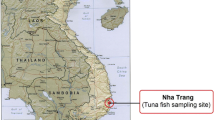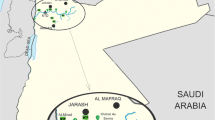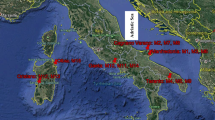Abstract
The neutron activation analysis was applied for investigation of elements temporal and spatial distribution among edible mussels. It allowed finding the levels of 29 macro and microelements in soft tissues and 24 in shells of such molluscs. For comparison, samples of wild and farmed mussels were collected from the sites with different anthropogenic pressure in the coastal zones of South Africa, Namibia, Mozambique, and Crimea. In general, the mussels from harbor zones contain higher levels of such elements of terrigenous origin such as Sc, V, Cr, Mn, Co, Ni, Sb, Cs, Th, U, while Co, Ni, Zn, As, Se, Br, I, Sb could have anthropogenic origin. According to our studies, the main factors which affect spatial variability of elements in the soft tissues and shells of mussels depend on the presence of resuspended bottom sediments, concentration, and content of phytoplankton, lithogenic composition of the coastal rocks, freshening of coastal waters, storm activities and hydrological parameters of environment waters and anthropogenic influence (wastewater discharges, marine transport, and harbor loadings).
Similar content being viewed by others
Explore related subjects
Discover the latest articles, news and stories from top researchers in related subjects.Avoid common mistakes on your manuscript.
INTRODUCTION
The distribution of macro and microelements in mussels were connected with the natural peculiarities and anthropogenic activities of the coastal zone. Mussels as the organisms-filtrators could be used as a biomonitors to control the harmful levels of toxic elements. In the pristine areas the salinity plays one of the main role affect the elemental levels in mussels’ tissue (Wang et al., 1996). To define the typical ranges of elements and the main temporal and spatial features of them should be the main task for each biomonitoring study. It is derived from the determination of background values, which is need for assessment of the environmental status of each local zone for proper management.
Our previous studies (Nekhoroshkov et al., 2021a, Nekhoroshkov et al., 2021b, Nekhoroshkov et al., 2022) raised the questions about the variabilities of levels of micro and macroelements in the mussels of wild and farmed origin. To solve this task, we aimed to define the ranges of differences in elemental composition of mussels from the selected coastal zones with various types of anthropogenic pressure (in the harbors, recreational zones and relatively pristine water areas) and origin (farmed and wild) as an additional task the temporal trends in the elemental levels were determined.
MATERIAL AND METHODS
The samples of wild and farmed mussels were collected in autumn and summer of 2013–2019 from the three stations situated in Saldanha bay (the west coast of South Africa). In addition, for comparison the less salinity water area, the wild mussels were sampled on the coast of the Crimea (the Black Sea); where for the same species of mussels the typical salinity was in two times lower than in Saldanha bay.
The mussels in Saldanha bay (Fig. 1) were collected from the three places: the wild from the st. 1 (Danger Bay), situated in the open coast and influenced by intense mixing and wave activities, st. 2 (Langebaan lagoon)—semi-closed bay near the Yacht club, and farmed ones from the st. 3 (Small Bay)—closed bay with relatively stable hydrological conditions.
For determination of the levels of elements in soft tissues and shells, the specimens were dissected, weighed, and packed in plastic bags for determination of elements with short-lived isotopes and in aluminum caps for elements with long-lived isotopes. The irradiation of samples was conducted at the REGATA facility of the reactor IBR-2 in FLNP. For short-lived isotopes, long-lived isotopes 1and long-lived isotopes 2 the induced gamma ray activities were measured during 15, 30, and 90 min after 2 min, 3 and 30 days respectively. The detailed procedure was described in Nekhoroshkov et al. (2021a, 2021b). In each set of samples, at least four standard reference materials were used for the quality assurance. Among all used standards, the uncertainties between determined and certified mass fractions were in the range of 0–10% for the most of elements. Such elements as Mg and Se were determined with the uncertainty less than 18%.
The mass fractions of 29 macro and microelements were determined in soft tissues and 24 in shells in each sample. Nonparametric Kruskal–Wallis test was applied for comparison of the pooled sets. The factor analysis performed by STATISTICA software was used for grouping the elements in mussel’s tissue according to their origin.
RESULTS AND DISCUSSIONS
It is important to note that higher levels of the average soft/shells ratios corresponded to elements such as Al, Cl, Sc, V, Zn, As, Se, which reached higher concentrations in soft tissues. The lowest levels of this ratio were found for Ca and Sr, which make up the shell material (aragonite and calcite) (Nekhoroshkov et al., 2021a).
To determine the probable origin of elements the enrichment factor (EF) values were calculated. It is the ratios between levels of elements in soft tissues to the non-volatile element (Sc in our case) corresponded to the same ratios in the average shale as the reference terrigenous matter (according to Neser et al., 1991 and Yuan-Hui et al., 1991). The obtained EF demonstrate higher levels for Cl, Zn, As, Se, Br, which could have additional source of origin and way of intake in the soft tissue. According to our previous studies, concentrations of these elements exceed the average shale that can be explained by geological specificity of the bottom sediments accumulated in mussels. It agreed with different levels of such terrigenous elements as V, Cr, Mn, Fe, U. Ca and Sr among stations, EF > 10, indicated the presence and influence of higher amounts of calcareous sediments, which could be accumulated with the inhaled waters.
In general, the variability of elements in mussels demonstrated instabilities in 2019. It could be explained by the higher storm events, which resuspend the bottom sediments and increased the general levels of microelements.
The typical higher levels of the majority of elements at st. 1 (Danger Bay) were determined in wild mussels, which grew in unstable hydrological situation with influence of high tides and waves in comparison with the mussels in semi-closed bays of the Saldanha (the Small Bay and Langebaan lagoon). Another source of elements is phytoplankton, which grazed by mussels in the bays.
According to factor analysis (Fig. 2), such elements as Al, Sc, V, Cr, Mn, Fe, Co, Th were considered in pristine areas as terrigenous, Na, Mg, Cl, K, As, Br, I were joined in one group that indicated on the interlinking of elements with the water salinity, Co, Ni, Sb, U could be considered as anthropogenic in several events, Ca, Sr interlinking with the deposition into shell and its construction, Na, Mg, Ca, As, Br, Sr, Cs could be considered as terrigenous (it means that they are derived from the coastal rock material) in cases of influence of storms (resuspension of bottom sediments). The connection of such elements as Na, Mg, Co, As, Br with several factors derived from the typical transport ways and different origin of the same elements in the mussel’s tissue.
The seasonal variability according to our studies depends on storm events, which increasing the levels of the majority of elements.
The levels of elements in mussels from the low salinity level regions (the Black Sea) were compared with the average ocean salinity level region (Saldanha Bay). The higher levels of Na, Mg, Cl, K, Cr, Ni, Se, Br, Rb, I, U were determined in mussels from the west coast of South Africa, Al, Sc, Co, Zn, As, Cs, Th were found at higher levels in mussels from the pristine areas of the Black sea.
CONCLUSIONS
The higher levels of Na, Mg, Cl, K, As, Br and I in mussel’s tissue indicated their interlinking with the water salinity, while Al, Sc, V, Cr, Mn, Fe, Co, Th are considered as terrigenous. Cl, Zn, As, Se, Br could be an anthropogenic origin due to their higher accumulation in mussels in comparison with typical average reference sediments (shale).
Such elements as Na, Mg, Co, As, Br revealed several different origin in the mussel’s tissue.
REFERENCES
P. Nekhoroshkov, I. Zinicovscaia, D. Nikolayev, T. Lychagina, A. Pakhnevich, N. Yushin, and J. Bezuidenhout, “Effect of the elemental content of shells of the bivalve mollusks (Mytilus galloprovincialis) from Saldanha Bay (South Africa) on their crystallographic texture,” Biology 10, 1093 (2021).
P. Nekhoroshkov, J. Bezuidenhout, I. Zinicovscaia, N. Yushin, K. Vergel, and M. Frontasyeva, “Levels of elements in typical mussels from the southern coast of Africa (Namibia, South Africa, Mozambique): Safety aspect,” Water 13, 3238 (2021).
P. Nekhoroshkov, I. Zinicovscaia, K. Vergel, D. Grozdov, O. Chaligava, and A. Kravtsova, “Macro- and microelements and radionuclides in the mussel Mytilus galloprovincialis from recreational and harbor sites of the Crimean Peninsula (The Black Sea),” Hydrobiology 1, 304 (2022).
G. Neşer, A. Kontas, D. Unsalan, E. Uluturhan, O. Altay, E. Darılmaz, F. Küçüksezgin, N. Tekoğul, and F. Yercan, “Heavy metals contamination levels at the coast of Aliaga (Turkey) ship recycling zone,” Marine Pollut. Bull. 64, 882–887 (2012).
K. Stroebel, P. Lochner, J. Conrad, and P. Naicker, “Geohydrological input into a strategic environmental assessment for the Greater Saldanha Area, Western Cape,” GEOSS Report No. 2019/05-14 (2019).
W. X. Wang, N. S. Fisher, and S. N. Luoma, “Kinetic determinations of trace element bioaccumulation in the mussel Mytilus edulis,” Marine Ecol. Prog. Ser. 140, 91–113 (1996).
L. Yuan-Hui, “Distribution patterns of the elements in the ocean: A synthesis,” Geochim. Cosmochim. Acta 55, 3223–3240 (1991).
Author information
Authors and Affiliations
Corresponding author
Ethics declarations
The author declares that he has no conflicts of interest.
Rights and permissions
About this article
Cite this article
Nekhoroshkov, P., Bezuidenhout, J., Zinicovscaia, I. et al. Neutron Activation Analysis for Studies of Elemental Variability in the Wild and Farmed Molluscs. Phys. Part. Nuclei Lett. 20, 1250–1253 (2023). https://doi.org/10.1134/S1547477123050588
Received:
Revised:
Accepted:
Published:
Issue Date:
DOI: https://doi.org/10.1134/S1547477123050588






